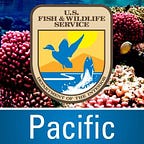Fire Destroys Bird Watching and Educational Overlook at Pearl Harbor National Wildlife Refuge
By Jordan Akiyama, Public Affairs Specialist, U.S. Fish and Wildlife Service
Fire destroyed the Betty Nagamine Bliss Overlook, part of the Honouliuli Unit of Pearl Harbor National Wildlife Refuge in ʻEwa Beach, last night. The outlook is closed and people are asked to avoid the area until further notice. The fire took place outside of typical visiting hours and no injuries were reported. Arson is suspected and the Honolulu Police Department and U.S. Fish and Wildlife Service Refuge Law Enforcement are investigating. If you have any information that can help, please contact: Tim Cusak, federal wildlife officer, 808–798–8709.
Pearl Harbor National Wildlife Refuge serves to protect some of the last remaining wetland areas on O‘ahu. The three units of this refuge, Honouliuli, Kalaeloa, and Waiawa, are vital to endangered wildlife and plants and sensitive coastal habitats. The refuge is home to a robust environmental education program and community and cultural partnerships — helping connect urban and wild spaces.
Refuge staff are currently evaluating the damage not only to the overlook, but if there was any damage to endangered Hawaiian waterbird habitat and the multi-million dollar predator proof fence that protects the refuge from invasive predators like cats, rats and mongoose.
“This is a devastating loss for the refuge and the community,” said Josh Ream, Pearl Harbor National Wildlife Refuge manager. “We are committed to working with Honolulu Police and will be working to make the area safe again for the public. Until then, we are asking people to avoid the area.”
The overlook, with views of West Loch, featured educational panels about Betty Nagamine Bliss’ work to help native birds, the endangered Hawaiian waterbirds visible on the refuge, and the West Loch disaster of May 21, 1944, when an explosion engulfed several ships. Each year, students visit the Honʻ ouli ʻuli Unit of the refuge and the overlook, learning about Hawaiian wetlands and the native birds that rely on protected spaces like these.
Bliss was a high school teacher at at McKinley High School in Honolulu. She helped establish the refuge in the 1970s and was an advocate for the endangered waterbirds that call the refuge home. The overlook was named in her honor in the hopes her legacy of education and connection with Hawaiian birds would live on at the refuge. The overlook was built as a partnership between the U.S. Fish and Wildlife Service, National Park Service, and U.S. Navy.
Visitors to the overlook could see the endangered aeʻo (Hawaiian stilt), ‘alae ke‘oke‘o (Hawiian coot), ‘alae ‘ula (Hawaiian gallinule), and koloa maoli (Hawaiian duck), as well as a variety of migratory shorebirds and waterfowl. The primary causes of the decline of Hawaiian waterbird species has been the loss and degradation of wetland habitat and introduced predators (e.g., rats, dogs, cats, mongoose).
The U.S. Fish and Wildlife Service is responsible for over ¾ billon acres of public lands and waters and 578 threatened and endangered species — over 2/3 of the species listed under the Endangered Species Act in the United States. Partnerships are essential to conservation in the Pacific, the Service works with partners and communities to recover listed species and prevent their extinction, and conserve lands and waters for the future.
The U.S. Fish and Wildlife Service works with others to conserve, protect, and enhance fish, wildlife, plants, and their habitats for the continuing benefit of the American people. For more information, connect with us through any of these social media channels at https://www.facebook.com/PacificIslandsFWS, www.flickr.com/photos/usfwspacific/, or www.twitter.com/USFWSPacific.
